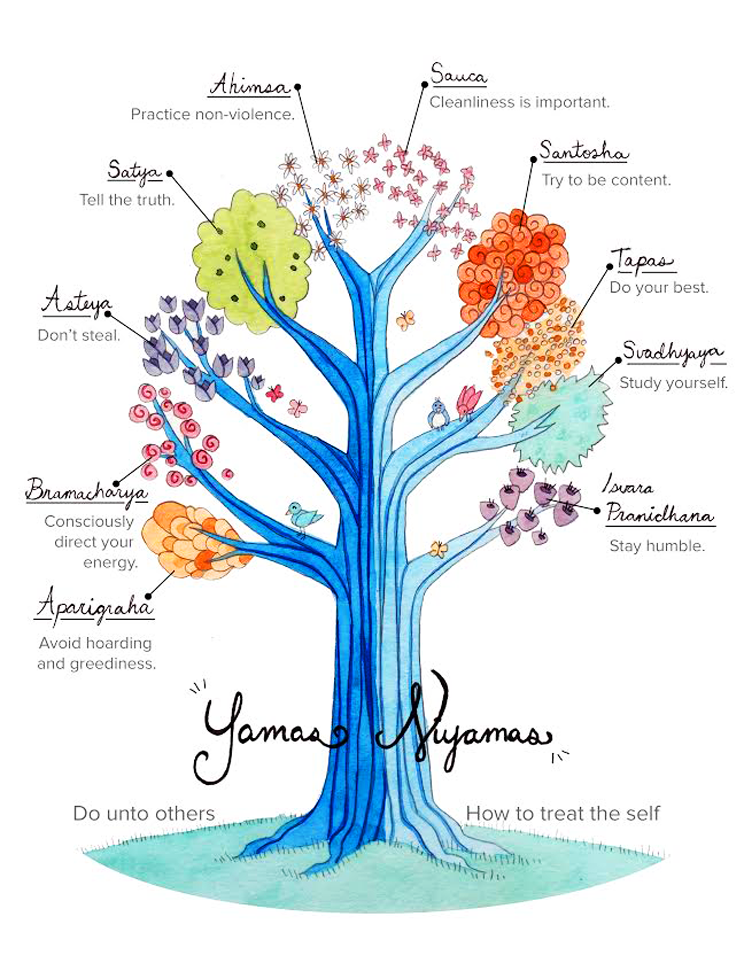
The Yoga Sutras by Patajali is a collection of 196 Sanskrit-language sutras. The texts were composed in the early years CE by Patanjali who compiled the wisdom of older yoga traditions. These sutras, which were initially a work-in-progress, are now considered one the most important sources worldwide for practicing yoga.
Four chapters make up the Yoga Sutras. The first chapter is dedicated to enlightenment, while the four following chapters are about the journey to that goal. The 52 sutras provide information on the benefits of meditation and kriyas. The 54/55 sutras detail Ashtanga and Karma yoga. The last two sutras explain the benefits of meditating on a regular basis.
Patanjali’s Yoga Sutras are regarded as the foundational text and basis of yoga. They are composed of 196 short verses. Although they date back to 400 B.C. scholars believe Patanjali wasn't the original creator of yoga but rather an excellent expounder of it. The sutras can be divided into five levels or padas.
The eighth limb is samadhi. This state of pure contemplation is the ultimate goal of yoga, and it is the most important one. According to the Sutras, Nirbija–samadhi (also known as seedless contemplation) is when the body and spirit are completely separated. This means that the mind can be freed from any ego and matter.

Yoga is a spiritual endeavour, and the Yoga Sutras serve as the basis. It involves the observation of the principles and practices of nature. The three qualities of nature are sattva, rajasa, and tamasva. The sattvayama is the most important and difficult to attain. Although it's not easy to see the purpose of each of these, ahimsa remains the most valuable of all four.
The Yama, Niyama, and Third sections make up the first book of Yoga Sutras. The first part is a biography, or biography of Patanjali. The most important yoga sutras can be found in the second volume. They also provide information on the history of yoga. In addition to the historical background, the sutras include a detailed discussion about the origins of yoga.
In the original text the Sutras from Patanjali are split into four distinct sections: Mahabhashya. Pranayama. Bhashya. The third chapter, the Mahabhashya, is an important chapter in the book. It outlines the theory and practice of yoga and explains the different stages of enlightenment. The defense of Panini makes up the fourth chapter.
The Yoga Sutras, which are Patanjali's most beloved part of the Patanjali-inspired text, are found in the second half. The words are written in Sanskrit, but the Sanskrit word for sutra means "thread". The Sutras are part of Hindu Scripture. It is the core of yoga. It was composed between 250 BCE and early centuries in the first millennium.
The Yoga Sutras are often dense, abstruse, and complex in terms of language and content. Due to their difficulty, it is highly recommended that you read a commentary about the Yoga Sutras. However, it is not an integral part of Yoga sutras. Although there is disagreement about the translations of Yoga sutras, the text remains the heart of the book. Some versions of the book use the word "asana" to refer to a single posture, while others have different versions of the same phrase.

The Yoga Philosophy Sutras from Patanjali are widely considered to be the most fundamental yogic text. Whether you want to practice yoga in the modern world or just learn the ancient techniques, you can benefit from studying the Sutras. They are also very relevant to modern yoga. It's up to you to decide how you want to use the Yoga Sutras. The Yoga Philosophy of Patanjali offers many benefits.
In a wide variety of sacred texts, Patanjali shares his insight. His writings define the eight limbs of yoga, the five types of yogi bodies, and the five qualities of a yogi's mind. These Sutras offer a wealth of inspiration to modern yogis and should be read. This book will help you understand the basic principles of Yoga.
FAQ
Eggs good for men
The egg has all the nutrients the body requires. It supports strong bones, healthy heart, lungs, and stable blood sugar.
Eggs are a great source of protein, vitamins A and B12, D. E. K, calcium, magnesium, selenium and riboflavin.
The egg yolk contains high levels of cholesterol. However, it does not contain saturated fat. Eggs contain less saturated fat than most other foods.
In addition, they are low in sodium and calories. You can make them in any way you like. They can be cooked in a variety of ways: poach, saute, bake, hard-boil or fry.
They are incredibly nutritious and easy to prepare.
Each day, you should consume at least 2 whole eggs. Avoid eating eggs.
Essential nutrients are found in eggs. Consider adding eggs to your daily meal plan today.
What diet supplement is best to lose weight?
Exercise and diet are key to losing weight. Some people find that certain supplementation can be helpful.
Studies have shown that omega-3 fatty acid may be beneficial in weight loss. Omega-3 fatty acids are essential fats that are vital for brain function, cell membrane integrity, and other functions. They can be found in seafoods like salmon, tuna or shrimp, as well as cod liver oil.
Green tea is being studied for its potential benefits in weight loss. The antioxidants in green tea, catechins and other compounds may increase metabolism and promote weight loss.
What is a good schedule for a 7-day work out?
A seven-day program should include three days of cardio training (running, biking and swimming), two strength exercise (using free weights or weight machines) and one flexibility/core work out (yoga, Pilates). Each activity should be performed at least once each week. Maximum 45 minutes should be allotted for each session.
Cardiovascular Exercise: Running/Biking/Swimming
It is important to complete at least 60 minutes of cardio per week. To achieve the best results, aim to exercise for at least 75 minutes each week. Cardio exercise can stimulate blood flow and increase muscle growth.
Strength Training
Cardio exercises work on the heart and lungs. Strength training works on the muscles and bones. Strength training helps you burn calories even while resting.
Flexibility & Core Workouts
Core and flexibility exercises are great ways of strengthening your whole body. Both yoga and Pilates can be great choices.
How do you lose weight?
It can be difficult to lose weight. Many people give up easily because they don't know what to do.
There are simple steps you can take in order to lose those extra pounds.
First, make sure you eat less calories than you burn. If you eat more calories that you burn, you'll gain weight.
You should also exercise regularly in order to lose all those calories. There are many types of exercise you can do, such as walking, running, cycling, and dancing.
Third, quit smoking cigarettes and alcohol. These habits lead to a higher intake of calories than usual.
Fourth, reduce your intake of fatty and processed foods. You can replace them with healthier options such as fruits, vegetables, lean meats, whole grains, nuts, seeds, beans, etc.
Fifth, you should change your lifestyle to adopt new habits. You might need to get up earlier every morning to do some exercise before going to work.
Sixth, discipline and following a diet plan are essential.
Finally, you have the option to join a gym and take part in an aerobics session to burn off those extra calories.
These simple tips will help you quickly see results.
Statistics
- According to the American Academy of Dermatology (AAD), men over 50 are at a heightened risk of developing it. (healthline.com)
- Cardmembers earn 5% Back at Amazon.com with a Prime Credit Card. (amazon.com)
- An estimated calorie range for moderately active adult males falls between 2,200 to 2,800 calories per day, depending on age. (eatright.org)
- Candidates and applicants must pass all four tests at 70% (minimum level) to graduate from Basic Deputy U.S. Marshal (BDUSM) Training. (usmarshals.gov)
- According to the American Heart Association, blood pressure should be checked at least once every two years, beginning at age 20. (my.clevelandclinic.org)
External Links
How To
What nutrients is a man supposed to consume daily?
Men need healthy growth and development. Vitamins, minerals, vitamins, nutrients, carbohydrates, fats and fiber are all essential for the body.
Also, the male body requires certain nutrients at specific times during the day. You can see that your body uses energy to make hormones. When you get up, protein is used to repair and build muscle.
Your body stores extra energy as glycogen and breaks down fat at night. Your body will still need nutrients, but it will require fewer calories during this time. You might have an occasional snack during the night if your stomach is feeling hungry.
Working out requires adequate carbohydrate and protein intake. If you train hard, you may experience muscle soreness after exercising.
To prevent this, you should eat carbs as well as protein within the first two hours after training. Your body will use stored glycogen to produce glucose for energy.
You must also eat protein right after you finish your workouts. This prevents the breakdown of muscle tissue that occurs while you sleep.
During periods of intense physical activity, your body produces lactic acid. Lactic acid builds up in the bloodstream and causes fatigue. Avoid this by eating foods rich in carbohydrates such as fruits or vegetables.
Carbohydrates provide energy for your body to recover after strenuous exercise.
A healthy diet should include lean meats such as fish, eggs and milk, cheese, yogurts, beans, seeds, nuts, and beans.
All of these foods contain high-quality protein. Protein promotes muscle growth, and helps repair damaged tissues. It provides amino acids that your body needs in order to produce sexhormones and testosterone.
A healthy skin, nails and joints requires sufficient dietary fats. Healthy men should consume between 20% to 35% of their daily caloric intake from fat.
Fat is good for your heart and helps you fight cancer. It also keeps your brain functioning properly.
Vegetable oils such as sunflower oil and soybean oil can provide most of your fat needs.
These oils are high in monounsaturated fatty acids (MUFAs). MUFAs can lower cholesterol levels and reduce inflammation. They protect your cells from damage by free radicals.
Saturated fats (SFAs), are found mainly in animal products such as meat, milk products, and butter. SFAs raise LDL ("bad") cholesterol and increase triglycerides. They can also increase weight and reduce belly fat.
Plant-based fats such as vegetable oils, seeds, nuts and grains contain polyunsaturated (PUFAs). PUFAs are good for your heart health and help to reduce inflammation. They are also good for controlling blood sugar and cholesterol.
Low HDL ("good") cholesterol is a common cause of erectile dysfunction in men. The consumption of saturated fats raises bad cholesterol which in turn lowers good cholesterol.
Men who eat a lot of red meat or pork develop prostate problems because they contain large amounts of nitrates. Nitrites convert to nitrosamines when cooked at high temperatures. These compounds cause cancer.
Most processed meats contain nitrites or other harmful chemicals. Avoid them completely.
The American Heart Association recommends limiting red meat intake to two meals per week. Instead, choose poultry and fish, legumes, tofu or whole grain bread as your main source of protein.